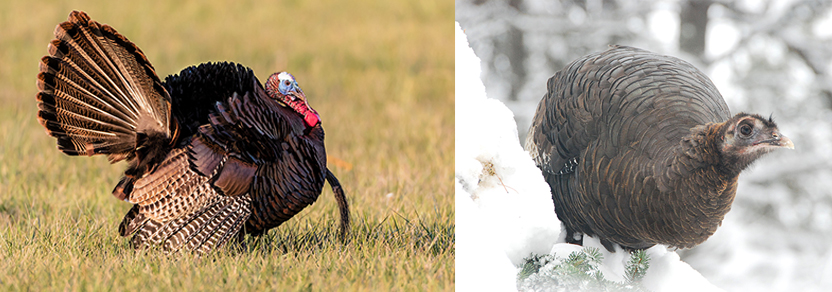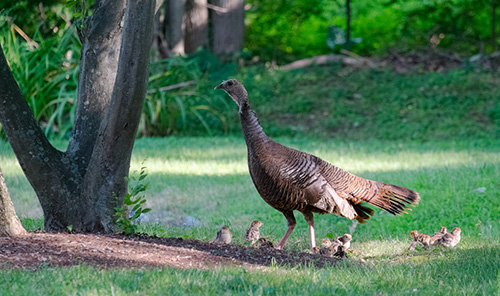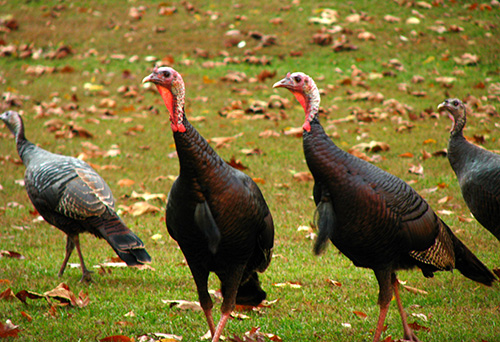Eastern Wild Turkey
(Meleagris gallopavo)
Description & Range:
Of the 5 distinct subspecies in North America, only the Eastern wild turkey resides Maryland. Wild turkeys are dark brown to black in color with many feathers that are iridescent, exhibiting a metallic green and bronze color. Male turkeys are called gobblers with adults (sometimes called toms) averaging around 18-22 lbs. During breeding season, their heads turn various shades of red, white, and blue. Female turkeys (called hens) are about half the size of gobblers, their plumage is duller, and they lack the bright head colors. Adult gobblers have spurs, a sharp, bony spike on the back of each of their legs. They also have a rough, black beard that protrudes from its breast. The beard can grow up to 12 inches long. Hens do not have spurs and usually do not have a beard, although bearded hens are not exceptionally rare. To view a guide to Wild Turkey aging and sexing, please
 click here.
click here.
Wild turkeys can be found in every county of the state thanks in part to an intensive trap and translocation effort by the department with assistance from the National Wild Turkey Federation. Although it was once thought that turkeys needed expansive tracts of forest to survive, the wild turkey is quite adaptable and some of the highest densities are now found in landscapes composed of a mosaic of agricultural lands and woodlots. Turkeys continue to adapt to human encroachment as well, sometimes taking up residence in suburban areas.

Male wild turkeys (left) have more colorful plumage than females (right).
Male turkey photo by Tim Lumley, Flickr CC BY-NC-ND 2.0. and Female photo by David Kazak.
Habitat:
Wild Turkey habitat needs vary depending on the time of year, but generally turkeys are found in or near forests. Trees provide safe roosting areas and produce much of the food that turkeys depend on such as acorns and other mast. However, turkeys spend many hours in open areas as well. Grassy and weedy fields produce insects that young turkeys (poults) need during the summer months. Nesting habitat may be the most limited but most important type of habitat turkeys utilize. Wild turkeys typically nest in overgrown fields or other areas with thick vegetation in the form of bushes, vines, and small trees to obscure a predator’s vision.
Diet:
Adult turkeys consume a wide variety of foods such as acorns, leaves, buds, seeds, fruits, waste grains, and insects. The primary food of poults for their first few weeks of life is protein-rich insects, but their diet becomes similar to the adult’s diet as they get older.
Reproduction:
During the breeding season, which occurs from March through July in Maryland, male turkeys display and gobble to attract females and to assert dominance over subordinate males within the flock or their territory. Once bred, hens will lay about 1 egg per day in a simple nest that is nothing more than a shallow depression on the ground. Incubation of the eggs will begin when the entire clutch is laid (usually about 9-12 eggs). After the 26-28 day incubation period, all the eggs will hatch and the poults will leave the nest with the hen within a short time. Poults are especially vulnerable when they young; Over 50% of the poults typically will die due to cold, wet weather or predators before they are able to fly and roost in trees.

Hen turkey and poults by Tim Venchus Flickr CC BY-NC 2.0
Sounds:
Turkeys use a variety of sounds for communication. The gobble is the most well-known, but they also use other calls such as yelps, clucks, purrs, and putts to attract mates, signal danger, or just keep in touch with the rest of the flock.
Behavior:
Wild turkeys spend most of the daylight hours on the ground with other turkeys. Flocks of up to 100 birds have been seen in fall and winter, but typically they travel in flocks of 10-30. Flocks will break into smaller groups prior to breeding and it is not uncommon to see single hens or gobblers during the nesting season. Turkeys are exceptionally adept at sensing danger with color vision 5 times more acute than humans and hearing 4 times better. Turkeys will almost always run when scared, but can fly up to 50 miles per hour for short distances.

Small flock of turkeys by Kerry Wixted
Management:
Wild turkeys are managed as Forest Game species in Maryland. To learn more about Wild Turkey management, then
click here.
If you are interested in managing for Wild Turkey habitat, then please
 click here.
click here.
Education:
The Wildlife and Heritage Service offers several education tools to teach about the wild turkey including a free wild turkey education trunk which can be borrowed up to two weeks at a time, pending availability. Wild turkey education resources include: